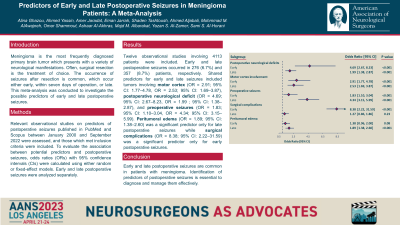Predictors of Early and Late Postoperative Seizures in Meningioma Patients: A Meta-Analysis
Predictors of Early and Late Postoperative Seizures in Meningioma Patients: A Meta-analysis
Friday, April 21, 2023

.jpg)
Alina Ghazou (she/her/hers)
Medical Student
Jordan University of Science and Technology
ePoster Presenter(s)
Introduction: Meningioma is the most frequently diagnosed primary brain tumor which presents with a variety of neurological manifestations. Often, surgical resection is the treatment of choice. The occurrence of seizures after resection is common, which occur either early, within seven days of operation, or late. This meta-analysis was conducted to investigate the possible predictors of early and late postoperative seizures.
Methods: Relevant observational studies on predictors of postoperative seizures published in PubMed and Scopus between January 2000 and September 2022 were assessed, and those which met inclusion criteria were included. To evaluate the association between potential predictors and postoperative seizures, odds ratios (ORs) with 95% confidence intervals (CIs) were calculated using either random or fixed-effect models. Early and late postoperative seizures were analyzed separately.
Results: Twelve observational studies involving 4113 patients were included. Early and late postoperative seizures occurred in 276 (6.7%) and 357 (8.7%) patients, respectively. Shared predictors for early and late seizures included tumors involving motor cortex (OR = 2.91; 95% CI: 1.77–4.78, OR = 2.53; 95% CI: 1.69–3.87), postoperative neurological deficit (OR = 4.69; 95% CI: 2.67–8.23, OR = 1.99 ; 95% CI: 1.38–2.87), and preoperative seizures (OR = 1.83; 95% CI: 1.10–3.04, OR = 4.34; 95% CI: 3.15–5.99). Peritumoral edema (OR = 1.89; 95% CI: 1.38–2.60) was a significant predictor only for late postoperative seizures while surgical complications (OR = 8.38; 95% CI: 2.22–31.59) was a significant predictor only for early postoperative seizures.
Conclusion : Early and late postoperative seizures are common in patients with meningioma. Identification of predictors of postoperative seizures is essential to diagnose and manage them effectively.
Methods: Relevant observational studies on predictors of postoperative seizures published in PubMed and Scopus between January 2000 and September 2022 were assessed, and those which met inclusion criteria were included. To evaluate the association between potential predictors and postoperative seizures, odds ratios (ORs) with 95% confidence intervals (CIs) were calculated using either random or fixed-effect models. Early and late postoperative seizures were analyzed separately.
Results: Twelve observational studies involving 4113 patients were included. Early and late postoperative seizures occurred in 276 (6.7%) and 357 (8.7%) patients, respectively. Shared predictors for early and late seizures included tumors involving motor cortex (OR = 2.91; 95% CI: 1.77–4.78, OR = 2.53; 95% CI: 1.69–3.87), postoperative neurological deficit (OR = 4.69; 95% CI: 2.67–8.23, OR = 1.99 ; 95% CI: 1.38–2.87), and preoperative seizures (OR = 1.83; 95% CI: 1.10–3.04, OR = 4.34; 95% CI: 3.15–5.99). Peritumoral edema (OR = 1.89; 95% CI: 1.38–2.60) was a significant predictor only for late postoperative seizures while surgical complications (OR = 8.38; 95% CI: 2.22–31.59) was a significant predictor only for early postoperative seizures.
Conclusion : Early and late postoperative seizures are common in patients with meningioma. Identification of predictors of postoperative seizures is essential to diagnose and manage them effectively.
